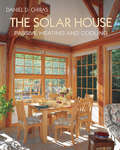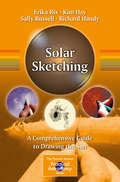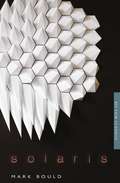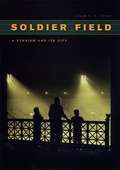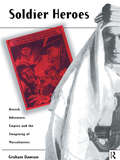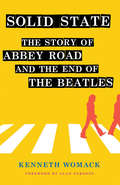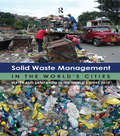- Table View
- List View
Solar Energy Houses: Strategies, Technologies, Examples
by Anne-Grete Hestnes Robert Hastings Bjarne SaxhofPassive and active solar strategies together with the adoption of energy conservation measures and the integration of new materials and technologies can lead to a dramatic reduction of 75-90 per cent in the energy consumption of the buildings. The objective of Task 13 of the IEA's Solar Heating and Cooling Programme was to advance solar building technologies and demonstrate this potential by designing and constructing buildings that met very low energy consumption targets while maintaining a good indoor climate. This revised second edition of this book presents the findings of the Task 13 experts and includes the results of the monitoring programme, conducted to determine the effectives of the techniques and strategies adopted. This new edition also provides a detailed explanation of this research programme in terms of how far the expectations of the Task experts were met and highlights the specific successes and lessons learned from the project.
Solar Home Design Manual for Cool Climates
by Shawna Henderson Don RoscoeIf you want an inexpensive, environmentally sound source of energy for your home, you need look no further than the sun. Solar heat is not subject to rate increases, is totally renewable, pollution free and requires little or no technology. It is here for you today, and can easily provide up to 50% of your space and water heating requirements. This is a book that simply and clearly explains the principles of using solar energy to heat your home. Anyone building a new home, or renovating an old one can incorporate one or several aspects of solar energy into their design. Taking you through the process of designing a solar home from the ground up this manual is also a basic course in conservation and sustainable house design. If you live in a 'heating' climate, meaning if you have space heating requirements for most of the year then this is an invaluable resource. A house is the biggest single investment most of us will make in our lives - the way it is built and how it operates can reflect a long term investment in both the building and the planet.
Solar Home Design Manual for Cool Climates
by Shawna Henderson Don RoscoeIf you want an inexpensive, environmentally sound source of energy for your home, you need look no further than the sun. Solar heat is not subject to rate increases, is totally renewable, pollution free and requires little or no technology. It is here for you today, and can easily provide up to 50% of your space and water heating requirements. This is a book that simply and clearly explains the principles of using solar energy to heat your home. Anyone building a new home, or renovating an old one can incorporate one or several aspects of solar energy into their design. Taking you through the process of designing a solar home from the ground up this manual is also a basic course in conservation and sustainable house design. If you live in a 'heating' climate, meaning if you have space heating requirements for most of the year then this is an invaluable resource. A house is the biggest single investment most of us will make in our lives - the way it is built and how it operates can reflect a long term investment in both the building and the planet.
The Solar House: Passive Heating and Cooling (Real Goods Solar Living Bks.)
by Daniel D. ChirasPassive solar heating and passive cooling—approaches known as natural conditioning—provide comfort throughout the year by reducing, or eliminating, the need for fossil fuel. Yet while heat from sunlight and ventilation from breezes is free for the taking, few modern architects or builders really understand the principles involved. Now Dan Chiras, author of the popular book The Natural House, brings those principles up to date for a new generation of solar enthusiasts. The techniques required to heat and cool a building passively have been used for thousands of years. Early societies such as the Native American Anasazis and the ancient Greeks perfected designs that effectively exploited these natural processes. The Greeks considered anyone who didn't use passive solar to heat a home to be a barbarian! In the United States, passive solar architecture experienced a major resurgence of interest in the 1970s in response to crippling oil embargoes. With grand enthusiasm but with scant knowledge (and sometimes little common sense), architects and builders created a wide variety of solar homes. Some worked pretty well, but looked more like laboratories than houses. Others performed poorly, overheating in the summer because of excessive or misplaced windows and skylights, and growing chilly in the colder months because of insufficient thermal mass and insulation and poor siting. In The Solar House, Dan Chiras sets the record straight on the vast potential for passive heating and cooling. Acknowledging the good intentions of misguided solar designers in the past, he highlights certain egregious—and entirely avoidable—errors. More importantly, Chiras explains in methodical detail how today's home builders can succeed with solar designs. Now that energy efficiency measures including higher levels of insulation and multi-layered glazing have become standard, it is easier than ever before to create a comfortable and affordable passive solar house that will provide year-round comfort in any climate. Moreover, since modern building materials and airtight construction methods sometimes result in air-quality and even toxicity problems, Chiras explains state-of-the-art ventilation and filtering techniques that complement the ancient solar strategies of thermal mass and daylighting. Chiras also explains the new diagnostic aids available in printed worksheet or software formats, allowing readers to generate their own design schemes.
Solar House: A Guide For The Solar Designer
by Terry GallowayCovering the full life span of the project, from siting issues through specific design features to maintenance of the property and equipment, this is a comprehensive guide to designing, planning and building a solar house. The author uses his experience of living in a solar house to inform the reader of the technology and practices needed for the design, operation and maintenance of the solar home. Each of the technologies of the house, such as space heating and cooling, domestic hot water and electric power technologies, are critiqued from the point of view of the owner/resident, with the author using his thirty years experience of living in a solar home. This provides home owners who are thinking of going solar with first hand evidence of best practice, and provides the architect and designer with the knowledge of how to best satisfy their clients needs.
Solar House
by Terry GallowayCovering the full life span of the project, from siting issues through specific design features to maintenance of the property and equipment, this is a comprehensive guide to designing, planning and building a solar house. The author uses his experience of living in a solar house to inform the reader of the technology and practices needed for the design, operation and maintenance of the solar home. Each of the technologies of the house, such as space heating and cooling, domestic hot water and electric power technologies, are critiqued from the point of view of the owner/resident, with the author using his thirty years experience of living in a solar home. This provides home owners who are thinking of going solar with first hand evidence of best practice, and provides the architect and designer with the knowledge of how to best satisfy their clients needs.
Solar Image Analysis and Visualization
by Jack Ireland C. Alex YoungThe SECCHI A and B instrument suites (Howard et al. , 2006) onboard the two STEREO mission spacecraft (Kaiser, 2005) are each composed of: one Extreme Ultra-Violet Imager (EUVI), two white-light coronagraphs (COR1 and COR2), and two wide-angle heliospheric imagers (HI1 and HI2). Technical descriptions of EUVI, COR1 and the HIs can be found in Wuelser et al. (2004), Thompson et al. (2003), and De?se et al. (2003), respectively. The images produced by SECCHI represent a data visualization challenge: i) the images are 2048×2048 pixels (except for the HIs, which are usually binned onboard 2×2), thus the vast majority of computer displays are not able to display them at full frame and full r- olution, and ii) more importantly, the ?ve instruments of SECCHI A and B were designed to be able to track Coronal Mass Ejections from their onset (with EUVI) to their pro- gation in the heliosphere (with the HIs), which implies that a set of SECCHI images that covers the propagation of a CME from its initiation site to the Earth is composed of im- ?1 ages with very different spatial resolutions – from 1. 7 arcsecondspixel for EUVI to 2. 15 ?1 arcminutespixel for HI2, i. e. 75 times larger. A similar situation exists with the angular scales of the physical objects, since the size of a CME varies by orders of magnitude as it expands in the heliosphere.
Solar Installations: Practical Applications for the Built Environment
by Lars AndrenSolar energy will play an important role in our future energy supply, to the advantage of both the environment and the economy. This book focuses on water-based solar heating technology, presenting basic principles on solar radiation and the solar heating system, including details on orientation and output, sizing, the solar collector, the solar circuit, heat exchangers, heat stores and overall system technology. A range of practical applications are described, such as multi- and single-family dwellings, pools, camp sites, sports facilities, schools and industry. The potential and diversity of solar energy is made clear with additional sections on solar electricity, passive solar and solar air heating.
Solar Installations: Practical Applications for the Built Environment
by Lars AndrenSolar energy will play an important role in our future energy supply, to the advantage of both the environment and the economy. This book focuses on water-based solar heating technology, presenting basic principles on solar radiation and the solar heating system, including details on orientation and output, sizing, the solar collector, the solar circuit, heat exchangers, heat stores and overall system technology. A range of practical applications are described, such as multi- and single-family dwellings, pools, camp sites, sports facilities, schools and industry. The potential and diversity of solar energy is made clear with additional sections on solar electricity, passive solar and solar air heating.
Solar Low Energy Houses of IEA Task 13
by Robert HastingsThe International Energy Agency's Task 13 is to advance solar building technologies. As part of that programme, 15 houses in 12 countries have been built to test new technologies and strategies for achieving low energy demand while maintaining a good indoor climate.;The principal strategies used and evaluated are: minimization of heat losses, profiting from passive solar and internal gains, heating with an active solar system, heating with recovered heat and providing auxiliary heat efficiently.;For each house, this work provides a list of energy features incorporated, an analysis of energy demand, a floor plan, and a description of methods of construction. The houses range from apartment blocks to detached and terraced housing. Local weather conditions, building styles and cultural requirements are taken into consideration.
Solar Low Energy Houses of IEA Task 13
by Robert HastingsThe International Energy Agency's Task 13 is to advance solar building technologies. As part of that programme, 15 houses in 12 countries have been built to test new technologies and strategies for achieving low energy demand while maintaining a good indoor climate.;The principal strategies used and evaluated are: minimization of heat losses, profiting from passive solar and internal gains, heating with an active solar system, heating with recovered heat and providing auxiliary heat efficiently.;For each house, this work provides a list of energy features incorporated, an analysis of energy demand, a floor plan, and a description of methods of construction. The houses range from apartment blocks to detached and terraced housing. Local weather conditions, building styles and cultural requirements are taken into consideration.
Solar Shading Systems: Design, Performance, and Integrated Photovoltaics (SpringerBriefs in Energy)
by Maria Mandalaki Theocharis TsoutsosThis is the first book to describe the development of and state of the art in solar shading devices in buildings, detailing all methods of evaluating shading systems according to thermal and visual comfort. The issue of energy balance in buildings is gaining importance as conventional energy sources dwindle and become more expensive. As such, environmental concerns should be considered in overall design decisions. The book discusses the role sun control “machines” play in controlling solar and thermal radiation. It examines their geometry, their position in relation to glazing and their operation (in the cases of movable systems) to control the heat and light entering a building, as well as how their material and color influence their performance. This book appeals to architects and designers who are interested in efficient energy facade design.
Solar Sketching: A Comprehensive Guide to Drawing the Sun (The Patrick Moore Practical Astronomy Series #178)
by Erika Rix Kim Hay Sally Russell Richard HandyFrom the authors of Sketching the Moon comes a comprehensive guide filled with richly illustrated, detailed drawing tutorials that cover a variety of solar phenomena. Explanations of what to expect visually from white light, Hydrogen-alpha and Calcium K filters are provided for those new to solar observing, along with essential tips on equipment, observing techniques and the practicalities of drawing at the eyepiece. Time-honored, traditional methods and media are described in tandem with innovative techniques developed and shared by contemporary astronomical sketchers. For the technically minded, detailed descriptions are given on how to use image manipulation software to bring your sketches to life through animation.The Sun is the most visually dynamic object in our solar system and offers compelling, spectacular views. Knotted magnetic field lines give rise to powerful eruptions and form the intricate sunspots and arching prominences that make our nearest star one of the most exciting, yet challenging, astronomical objects to sketch. Facilitated by the availability of affordable dedicated solar telescopes and filters, the Sun has become an increasingly popular target amongst astronomical sketchers. The use of narrowband solar filters provides a wonderful opportunity to capture views of the Sun that have, until recently, been largely inaccessible.You’ll discover easy to follow, step-by-step instructions geared toward your specific interests, be it technical sketching and contributing to science, personal study, or even fun solar outreach activities that help children learn through art. By using Solar Sketching as a reference, drawing the Sun has never been easier.
Solar Thermal Systems: Successful Planning and Construction
by Dr Felix Peuser Karl-Heinz Remmers Martin SchnaussSolar Thermal Systems summarizes the theoretical and practical knowledge gained from over 20 years of research, implementation and operation of thermal solar installations. This work provides answers to a variety of key questions by examining current solar installations, drawing upon past experiences and making proposals for future planning. - how do system components and materials behave under continuous operation? - which components have proven themselves and how are they used properly? - what are the causes of defects and how can they be avoided? - how long is the service life of modern solar installations? - what is the difference between the various solar collectors? - what performance can be expected from solar installations? - how are solar installations planned and structured correctly? In addition to practical recommendations on implementation, the theoretical background is also clearly explained. This book is a valuable guide for all those who deal with solar technology and at the same time a reference for the daily work of planners and fitters. It will also prove a useful tool for training and education.
Solar Thermal Systems: Successful Planning and Construction
by Dr Felix Peuser Karl-Heinz Remmers Martin SchnaussSolar Thermal Systems summarizes the theoretical and practical knowledge gained from over 20 years of research, implementation and operation of thermal solar installations. This work provides answers to a variety of key questions by examining current solar installations, drawing upon past experiences and making proposals for future planning. - how do system components and materials behave under continuous operation? - which components have proven themselves and how are they used properly? - what are the causes of defects and how can they be avoided? - how long is the service life of modern solar installations? - what is the difference between the various solar collectors? - what performance can be expected from solar installations? - how are solar installations planned and structured correctly? In addition to practical recommendations on implementation, the theoretical background is also clearly explained. This book is a valuable guide for all those who deal with solar technology and at the same time a reference for the daily work of planners and fitters. It will also prove a useful tool for training and education.
Solar Thermal Technologies for Buildings: The State of the Art (BEST (Buildings Energy and Solar Technology))
by M. SantamourisSolar thermal is now a proven technology in terms of reliability, cost-benefit, and low environmental impact. The integration of solar thermal systems and installations into the design of buildings can provide a clean, efficient and sustainable low-energy solution for heating and cooling, whilst, taken in a wider context, contributing to climate protection. This book covers the state of the art in the application of solar thermal technologies for buildings. This is the first book in the BEST (Buildings, Energy and Solar Technology) Series. This series presents high-quality theoretical and application-oriented material on solar energy and energy-efficient technologies. Leading international experts cover the strategies and technologies that form the basis of high-performance, sustainable buildings, crucial to enhancing our built and urban environment.
Solar Thermal Technologies for Buildings: The State of the Art (BEST (Buildings Energy and Solar Technology))
by M. SantamourisSolar thermal is now a proven technology in terms of reliability, cost-benefit, and low environmental impact. The integration of solar thermal systems and installations into the design of buildings can provide a clean, efficient and sustainable low-energy solution for heating and cooling, whilst, taken in a wider context, contributing to climate protection. This book covers the state of the art in the application of solar thermal technologies for buildings. This is the first book in the BEST (Buildings, Energy and Solar Technology) Series. This series presents high-quality theoretical and application-oriented material on solar energy and energy-efficient technologies. Leading international experts cover the strategies and technologies that form the basis of high-performance, sustainable buildings, crucial to enhancing our built and urban environment.
Solaris (BFI Film Classics)
by Mark BouldDespite being one of Andrei Tarkovsky's most successful films, Solaris (1972) was the one he most disliked. This dismissal of his most generically marked film has often been accepted by those quick to embrace the image of Tarkovsky as a transcendent artist rising above the politics of the Soviet film industry and the trappings of genre to produce personal works of art.Going against such currents, Mark Bould instead treats Solaris as the product of a genre as well as the work of a skilled film-maker. He teases out Tarkovsky's fascination with Stanislaw Lem, on whose novel the film was based, and also considers Steven Soderbergh's 2002 adaptation. Lively and revealing, Bould's examination situates Solaris within the Russian and global cultures of the fantastic, to which Tarkovsky contributed three major science fiction films.This special edition features original cover artwork by Matthew Shlian.
Soldier Field: A Stadium and Its City (Chicago Visions and Revisions)
by Liam T. FordSports fans nationwide know Soldier Field as the home of the Chicago Bears. For decades its signature columns provided an iconic backdrop for gridiron matches. But few realize that the stadium has been much more than that. Soldier Field: A Stadium and Its City explores how this amphitheater evolved from a public war memorial into a majestic arena that helped define Chicago. Chicago Tribune staff writer Liam Ford led the reporting on the stadium’s controversial 2003 renovation—and simultaneously found himself unearthing a dramatic history. As he tells it, the tale of Soldier Field truly is the story of Chicago, filled with political intrigue and civic pride. Designed by Holabird and Roche, Soldier Field arose through a serendipitous combination of local tax dollars, City Beautiful boosterism, and the machinations of Mayor “Big Bill” Thompson. The result was a stadium that stood at the center of Chicago’s political, cultural, and sporting life for nearly sixty years before the arrival of Walter Payton and William “The Refrigerator” Perry. Ford describes it all in the voice of a seasoned reporter: the high school football games, track and field contests, rodeos, and even NASCAR races. Photographs, including many from the Chicago Park District’s own collections, capture these remarkable scenes: the swelling crowds at ethnic festivals, Catholic masses, and political rallies. Few remember that Soldier Field hosted Billy Graham and Martin Luther King Jr., Judy Garland and Johnny Cash—as well as Grateful Dead’s final show. Soldier Field captures the dramatic history of Chicago’s stadium on the lake and will captivate sports fans and historians alike.
Soldier Field: A Stadium and Its City (Chicago Visions and Revisions)
by Liam T. FordSports fans nationwide know Soldier Field as the home of the Chicago Bears. For decades its signature columns provided an iconic backdrop for gridiron matches. But few realize that the stadium has been much more than that. Soldier Field: A Stadium and Its City explores how this amphitheater evolved from a public war memorial into a majestic arena that helped define Chicago. Chicago Tribune staff writer Liam Ford led the reporting on the stadium’s controversial 2003 renovation—and simultaneously found himself unearthing a dramatic history. As he tells it, the tale of Soldier Field truly is the story of Chicago, filled with political intrigue and civic pride. Designed by Holabird and Roche, Soldier Field arose through a serendipitous combination of local tax dollars, City Beautiful boosterism, and the machinations of Mayor “Big Bill” Thompson. The result was a stadium that stood at the center of Chicago’s political, cultural, and sporting life for nearly sixty years before the arrival of Walter Payton and William “The Refrigerator” Perry. Ford describes it all in the voice of a seasoned reporter: the high school football games, track and field contests, rodeos, and even NASCAR races. Photographs, including many from the Chicago Park District’s own collections, capture these remarkable scenes: the swelling crowds at ethnic festivals, Catholic masses, and political rallies. Few remember that Soldier Field hosted Billy Graham and Martin Luther King Jr., Judy Garland and Johnny Cash—as well as Grateful Dead’s final show. Soldier Field captures the dramatic history of Chicago’s stadium on the lake and will captivate sports fans and historians alike.
Soldier Heroes: British Adventure, Empire and the Imagining of Masculinities
by Graham DawsonSoldier Heroes explores the imagining of masculinities within adventure stories. Drawing on literary theory, cultural materialism and Kleinian psychoanalysis, it analyses modern British adventure heroes as historical forms of masculinity originating in the era of nineteenth-century popular imperialism, traces their subsequent transformations and examines the way these identities are internalized and lived by men and boys.
Soldier Heroes: British Adventure, Empire and the Imagining of Masculinities
by Graham DawsonSoldier Heroes explores the imagining of masculinities within adventure stories. Drawing on literary theory, cultural materialism and Kleinian psychoanalysis, it analyses modern British adventure heroes as historical forms of masculinity originating in the era of nineteenth-century popular imperialism, traces their subsequent transformations and examines the way these identities are internalized and lived by men and boys.
Solid State: The Story of "Abbey Road" and the End of the Beatles
by Kenneth WomackAcclaimed Beatles historian Kenneth Womack offers the most definitive account yet of the writing, recording, mixing, and reception of Abbey Road.In February 1969, the Beatles began working on what became their final album together. Abbey Road introduced a number of new techniques and technologies to the Beatles' sound, and included "Come Together," "Something," and "Here Comes the Sun," which all emerged as classics. Womack's colorful retelling of how this landmark album was written and recorded is a treat for fans of the Beatles. Solid State takes readers back to 1969 and into EMI's Abbey Road Studio, which boasted an advanced solid state transistor mixing desk. Womack focuses on the dynamics between John, Paul, George, Ringo, and producer George Martin and his team of engineers, who set aside (for the most part) the tensions and conflicts that had arisen on previous albums to create a work with an innovative (and, among some fans and critics, controversial) studio-bound sound that prominently included the new Moog synthesizer, among other novelties. As Womack shows, Abbey Road was the culmination of the instrumental skills, recording equipment, and artistic vision that the band and George Martin had developed since their early days in the same studio seven years earlier. A testament to the group's creativity and their producer's ingenuity, Solid State is required reading for all fans of the Beatles and the history of rock 'n' roll.
Solid Waste Management in the World's Cities: Water and Sanitation in the World's Cities 2010
by Un-HabitatIn our rapidly urbanizing global society, solid waste management will be a key challenge facing all the world's cities. Solid Waste Management in the World's Cities provides a fresh perspective and new data on one of the biggest issues in urban development. Using the framework of Integrated Sustainable Waste Management (ISWM), the report brings together unprecedented research from 22 cities across six continents. It uncovers the rich diversity of waste management systems that are in place throughout the world, and draws out the practical lessons for policymakers. The volume will be essential reading for all professionals and policymakers in the field, as well as a valuable resource for researchers and students in all aspects of urban development. Winner of the International Solid Waste Association Publication Award 2010 Published with UN-Habitat.
Solid Waste Management in the World's Cities: Water and Sanitation in the World's Cities 2010
by Un-HabitatIn our rapidly urbanizing global society, solid waste management will be a key challenge facing all the world's cities. Solid Waste Management in the World's Cities provides a fresh perspective and new data on one of the biggest issues in urban development. Using the framework of Integrated Sustainable Waste Management (ISWM), the report brings together unprecedented research from 22 cities across six continents. It uncovers the rich diversity of waste management systems that are in place throughout the world, and draws out the practical lessons for policymakers. The volume will be essential reading for all professionals and policymakers in the field, as well as a valuable resource for researchers and students in all aspects of urban development. Winner of the International Solid Waste Association Publication Award 2010 Published with UN-Habitat.


